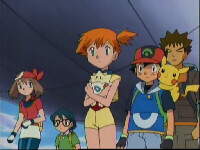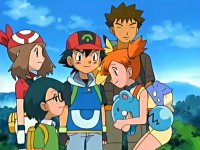Generation 3
Timespan: November 21st 2002 - September 27th 2006
Number of new Pokémon: 135
Number of new Moves: 104
Region: Hoenn
Three years after Pokémon Gold & Silver were released, Pokémon Ruby & Sapphire came on the scene. The games were the first on the Game Boy Advance and following buildup in the anime and movies, acted as a soft reboot for the series. Having cut off connectivity from the previous games, Pokémon Ruby & Sapphire provided a fresh start on the series. Adding a massive 135 Pokémon to the series, it changed things up with the addition of Double Battles, Abilities, Natures and so much more.
Pokémon | Main Games | Side Games | Spin-off Games | Anime | Trading Card Game |
| Pokémon Ruby & Sapphire | |
 |
Release Dates: Japan: November 21st 2002 North America: March 17th 2003 Europe: July 25th 2003 Console: Game Boy Advance Pokémon Ruby & Sapphire were the first Generation III Pokémon games. As a soft reboot, it introduced a massive amount of new Pokémon as you played as a new trainer who just moved to the Hoenn region. Your task as usual was to defeat the 8 gyms and become the champion, but along the way you had to deal with Team Aqua or Team Magma, depending on your game, who wanted to awaken the Legendary Pokémon and use them to fulfil their goal. It added a myriad of new mechanics to the series which have become standard to the day. |
| Pokémon FireRed & LeafGreen | |
 |
Release Dates: Japan: January 29th 2004 North America: September 9th 2004 Europe: October 1st 2004 Console: Game Boy Advance Pokémon FireRed & LeafGreen were the first remakes of Pokémon games. To make up for the lack of connectivity and missing 184 Pokémon, the original Pokémon Red & Green were remade for the GameBoy Advance. Once again you played through Kanto, defeating Team Rocket, but the games also introduced a new mini-region, the Sevii Islands, which added more to the lore. The games were shipped with a Wireless Adapter, allowing for wireless battles & trades. |
| Pokémon Emerald | |
 |
Release Dates: Japan: September 16th 2004 North America: May 1st 2005 Europe: October 21st 2005 Console: Game Boy Advance Pokémon Emerald was the enhanced version of Pokémon Ruby & Sapphire. This game took Ruby & Sapphire and combined the stories, allowing for you to face off against both Team Magma and Team Aqua, both of whom are intent on awakening Legendary Pokémon. This brings it to a head with the Legendary Pokémon Rayquaza appearing. This game introduced the Battle Frontier, a group of facilities that put a new spin on battles. |
| Pokémon Box: Ruby & Sapphire | |
 |
Release Dates: Japan: May 30th 2003 North America: July 11th 2004 Europe: August 2004 Console: Nintendo Gamecube Pokémon Box: Ruby & Sapphire is a storage utility akin to that seen in Pokémon Stadium games. Using this, you could store up to 1,500 Pokémon onto one Nintendo Gamecube Memory Card save file at any one time from your Pokémon Ruby & Sapphire games. As you progressed, it would unlock more special event Pokémon for you, up to a Surfing Pichu. |
| Pokémon Colosseum | |
 |
Release Dates: Japan: November 21st 2003 North America: March 22nd 2004 Europe: May 14th 2004 Console: Nintendo Gamecube Dropping the Battle Simulator aspects of Pokémon Stadium, Pokémon Colosseum changes its course and went for a full story based RPG. This game had you play as a character called Wes, formerly a Team Snagem member, who stole a Snag Machine which is used to capture other trainer's Pokémon. As many Pokémon are starting to become "Shadow Pokémon", the game tasked you with capturing all 48. These could then be sent to the main games. It also had several Colosseums of trainers to face through in modes akin to Pokémon Stadium |
| Pokémon XD: Gales of Darkness | |
 |
Release Dates: Japan: August 4th 2005 North America: October 3rd 2005 Europe: November 18th 2005 Console: Nintendo Gamecube Pokémon XD: Gales of Darkness is a sequel to Pokémon Colosseum and has you return to the Orre Region as a new trainer, once again liberating Shadow Pokémon from various trainers. Like before it has Colosseums to face through but also the unique modes of Battle CDs and Battle Bingo. It also had multiplayer features as well as the first appearances in-game of some Generation IV Pokémon |
| Pokémon Channel | |
 |
Release Dates: Japan: July 18th 2003 North America: December 1st 2003 Europe: April 2nd 2003 Console: Nintendo Gamecube Pokémon Channel was the spiritual successor to Hey You, Pikachu. In this game, you once again looked after a Pikachu, going out on adventures with it, but the meat of the game was the ability to watch TV with Pikachu. The channels included various quizzes, anime and shop to decorate your room. In Europe, it gave you a Jirachi to your main series games. |
| Pokémon Dash | |
 |
Release Dates: Japan: December 2nd 2004 North America: March 14th 2005 Europe: March 11th 2005 Console: Nintendo DS Pokémon Dash was the first Nintendo DS game released for Pokémon and had you control Pikachu to race through various courses by using the touch screen to navigate. The courses involved going up on balloons and crossing various terrain to hit markers. If you had a GameBoy Advance main series Pokémon game plugged into your console, then you could also race on courses based on your Pokémon team. |
| Pokémon Mystery Dungeon - Red Rescue Team & Blue Rescue Team | |
 |
Release Dates: Japan: November 17th 2005 North America: September 18th 2006 Europe: November 10th 2006 Console: Game Boy Advance (Red), Nintendo DS (Blue) Pokémon Mystery Dungeon - Red Rescue Team & Blue Rescue Team were the first Mystery Dungeon games. This game had two versions, one on the GameBoy Advance and one on the Nintendo DS each with different Pokémon within. This game had you play as a human who had turned into the Pokémon and tasked you with going through dungeons, recruiting Pokémon and trying to find out why you changed into a Pokémon |
| Pokémon Pinball: Ruby & Sapphire | |
 |
Release Dates: Japan: August 1st 2003 North America: August 25th 2003 Europe: November 13th 2003 Console: GameBoy Advance Pokémon Pinball: Ruby & Sapphire was the successor to the original Pokémon Pinball and featured similar mechanics. You went through the Ruby and Sapphire tables, once again to capture all the Pokémon in the Hoenn Pokédex. This is done by collecting items and hitting spots in order to activate the capture. |
| Pokémon Ranger | |
 |
Release Dates: Japan: March 23rd 2006 North America: October 30th 2006 Europe: April 13th 2007 Console: Nintendo DS Pokémon Ranger was the first Pokémon Ranger game and had you play as a Ranger and go through the Fiore region, using the Capture Styler on the Nintendo DS touch screen to temporarily control Pokémon to help you face obstacles an capture other Pokémon in order to stop the plans of the evil Go-Rock Squad |
| Pokémon Trozei | |
 |
Release Dates: Japan: October 20th 2005 North America: March 6th 2006 Europe: May 5th 2006 Console: Nintendo DS Pokémon Trozei was a puzzle game where you had to match multiple of the same Pokémon by shifting rows and columns across the table. In the game, you played as Lucy Fleetfoot as she tried to stop the Phobos Batallion from capturing all the Pokémon by finding them and defeating them in various puzzles. |
| Pokémon Advanced | |

|
Advance Generation: |
| Pokémon Battle Frontier | |

|
The Battle Frontier: |
The Trading Card Game added some new mechanics within the third generation. In it, it added special Pokémon-ex cards which are more powerful but give 2 Prize Cards when defeated.
| Set Name | Number of Cards | Logo |
| EX Ruby and Sapphire | 109 |  |
| EX Sandstorm | 100 |  |
| EX Dragon | 100 |  |
| EX Team Magma VS Team Aqua | 97 |  |
| EX Hidden Legends | 102 |  |
| EX FireRed and Leaf Green | 116 |  |
| EX Team Rocket Returns | 111 |  |
| EX Deoxys | 109 |  |
| EX Emerald | 107 |  |
| EX Unseen Forces | 145 |  |
| EX Delta Species | 114 |  |
| EX Legend Maker | 93 |  |
| EX Holon Phantoms | 111 |  |
| EX Crystal Guardians | 100 |  |
| EX Dragon Frontiers | 101 |  |
| EX Power Keepers | 108 |  |
